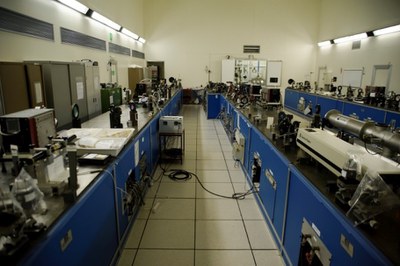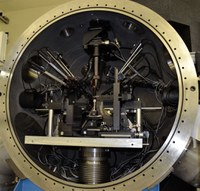ENEA-ABC (Frascati, Italy)
Research highlights
ENEA-ABC
ENEA ABC Facility, Frascati, Italy

Laser interaction with micro-structured materials (foams)
We characterize laser interaction with micro-structured materials (foams), and in particular measurement: of the ablation loading on a solid substrate with a foam buffer; of the propagation speed of the laser-driven hydrothermal wave in a foam; of the laser light reflected by a foam, in time-domain, to give an estimate of the homogenization time of the foam by combining simulations and experimental results. This is accompanied to the development and benchmarking of hydrocodes for laser-foam interaction, like the MULTI-FM one, including an effective model for absorption, transmission and reflection of laser light, thermal conduction and mechanical behavior of the foam. [High Power Laser Science and Engineering 9, e40 (2021)]
Techniques and devices for the measurement of laser-driven electromagnetic pulses (EMPs)
Laser-matter interaction at high intensity generated electromagnetic radiation in frequency range of microwaves, up to the ThZ level, with electric fields up to the MV/m order. These fields potentially represent a hazard and a stress factor for electronic equipment. We study methodologies and tools for calibrated measurements of these fields (in terms of intensity and spectral components), allowing to evaluate their damage potential on surrounding equipment and/or exposed materials. [High Power Laser Science and Engineering 8, e22 (2020)] [High Power Laser Science and Engineering 9, e64 (2021)]
Generation of laser-driven electromagnetic fields for applications
The laser-matter interaction driven electromagnetic pulses (EMPs) can be also used for applications, if generated ad-hoc and well characterized. We developed and patented a platform for the laser-generation of controlled EMPs, confined in a small space region (in the order of cm^3), with electric field intensities of hundreds of kV/m. These fields, with a duration in the scale of ns, can be potentially used for experiments of medical applications, material science and particle acceleration. [ENEA Patent «A method of generating high-intensity electromagnetic fields» PCT/IB2020/057464,WO2021/024226]. Project LIBERO of the EUROfusion Technology Transfer FUTTA call 2022.
Optimization of methodologies for the detection of laser-accelerated ions via Thomson Spectrometry
Thomson spectrometry is a well-established technique for the detection and differentiation of laser-accelerated ions, ranging from the keV energy level up to several MeVs. We design, develop and implement high-sensitivity Thomson spectrometers, which are designed for operating in harsh environments, withstanding high-level of background radiation noise and simultaneously detect low particle fluency. [Journal of Instrumentation 15, C10013 (2020)] [Laser and Particle Beams, 3531875 (2023)]
Development of novel time-of-flight diagnostics based on diamond detectors
We use diamond-based crystalline detectors for the time-of-flight detection of laser accelerated ions, allowing a real time, calibrated measurement of the generated particle energy spectrum. The developed detectors have different design features that make them optimized for specific energy ranges (from keVs up to MeVs) and sensitivity levels. Innovative configurations using multiple stacked detectors, for an improved capability of differentiating ion species, have been developed recently. [High Power Laser Science and Engineering 10, e6 (2022)]
Interaction of GHz/THz with human cells
The GREAM project, financed by the Italian Ministry of Defence, was realised in collaboration with the Scientific Department of Army Medical Center of Rome, and the Universities of Rome “La Sapienza”, “Tor Vergata” and “Roma Tre”. It’s focused on the study of potential genotoxic effects induced on different kind of human fibroblasts, after irradiation with the ENEA Compact FEL source, in the 100-150 GHz frequency range, and with a YIG source at 25 GHz [Bioelectromagnetics, 28, 8, 587-598 (2007)].
THz for Cultural Heritage
The THz-ARTE project, in the field of Cultural Heritage preservation, was carried out in the frame of a bilateral collaboration between Italy and Japan. For this project an innovative THz imaging system was realized using a phase sensitive detection technique. This imaging system has been successfully operated on real ancient paintings [Applied Sciences 10 (21), 7661 (2020)].
Expertise
ENEA - Centro Ricerche Frascati is one of the main Italian and international research centers dedicated to nuclear fusion, laser sources and particle accelerators. It hosts the ABC laser (2x100 J beams, 3-7 ns duration, l = 1054/527 nm, up to 1015 W/cm2 intensity) used for experiments of inertial confinement fusion and laser-matter interaction. Thanks to the wide range of diagnostics, the facility is capable to supply Institutions and industries both main laser beams and high power (> 100 MW) secondary radiation sources: transient plasmas, electrons, protons, UV-X, radiofrequency-microwave (thanks to ENEA patent, uniform fields over large (dm3) volumes).
The research group of the ABC facility has wide expertise on
- characterization of the laser-plasma interaction over a wide range of different diagnostics
- implementation and characterization of novel target types (e.g. foam targets) for studying different laser-plasma interaction regimes
- calibrated detection of laser-plasma interaction products: electrons, ions, ionizing- and non-ionizing radiation
The ENEA-Frascati center has also a consolidated expertise in the development of THz sources (Compact FEL, FIR Laser, solid state source) and their applications in a variety of fields, including material properties, biological studies, imaging for art conservation, imaging of dielectric materials, including plastics, diagnostics for fusion plasmas. The Compact Free Electron Laser Source emits tunable radiation, in the spectral range between 0.1 and 0.15 THz. Average power is in the mW range while peak power is in the kW range, making it an ideal source for experiments where E fields effects have to be studied, avoiding the heating of the sample.
Expertise in recyclable materials
 The very wide range of sources – primary and secondary – present at ENEA Centro Ricerche Frascati enables broadband characterization of recyclable material properties and allows to perform a great variety of tests on them, in particular those related to radiation hardness. The generation and measurement techniques of high-intensity pulsed fields have an impact on material science applications that also involve studies on the implementation of recyclable materials. Commonly studied parameters of novel, eco-sustainable materials are their electric features, especially when these materials are used for high electric field environments and components. These techniques are suitable for investigating the voltage breakdown limit if these materials, and represent an important tool for enabling and benchmark their use also in applications with very high transient electric fields.
The very wide range of sources – primary and secondary – present at ENEA Centro Ricerche Frascati enables broadband characterization of recyclable material properties and allows to perform a great variety of tests on them, in particular those related to radiation hardness. The generation and measurement techniques of high-intensity pulsed fields have an impact on material science applications that also involve studies on the implementation of recyclable materials. Commonly studied parameters of novel, eco-sustainable materials are their electric features, especially when these materials are used for high electric field environments and components. These techniques are suitable for investigating the voltage breakdown limit if these materials, and represent an important tool for enabling and benchmark their use also in applications with very high transient electric fields.
The ENEA sources have already been used to characterize and also calibrate, under extreme irradiation conditions, detectors made of recyclable materials or meant for activities performed on recyclable materials.
>> Watch the Laserlab-Europe Talk 'Lasers, related radiation sources and diagnostics at ENEA-Frascati for applications to material science, radiation hardness of materials and components'
Services for Industry
We provide the main ABC laser pulses (2x100 J beams, 3-7 ns duration, l = 1054/527 nm, up to 1015 W/cm2 intensity). These pulses drive high power (> 100 Mw) secondary radiation sources such as:
- Transient plasmas, from solid materials that can be freely chosen, with temperatures up to hundreds eV and densities that can be varied over extremely wide ranges.
- Electrons, up to 1011 per shot.
- ‘thermal’ up to a few keV
- ‘hot’ up to a few hundred keV
- Protons, more than 1011 per shot, up to one hundred keV
- UV-soft X having maximum intensity up to a few keV, with tails up to a few tens of keV. Duration: 3-10 ns
- Radiofrequency-microwave: duration 3-100 ns. Intensity up to the MV/m order on large volumes (several dm3) thanks to ENEA patent, with spatially uniform fields.
THz sources of different frequencies and intensities can be provided by the many ENEA devices: compact FEL, FIR Gas Laser, THz Optical generation (Auston switch and/or optical rectification), Low frequency YIG system, with frequencies from a few tens GHz up to 150 GHz, and from a few mW to a few kW powers.
All these sources can be used for industrial applications, including, e.g., stress testing of irradiated materials and/or irradiated devices, calibration of commercial measurement devices for particles and/or electromagnetic radiation, biological studies like tests and imaging of living cells, aerospace applications, EMI and radiation hardness tests, material properties, imaging for art conservation, imaging of dielectric materials.
Equipment offered to external users
The ABC laser
 This is the largest Italian laser plant, and that with the larger energy per pulse (100 J at 1054 nm or 40 J at 527 nm, nominal) per two simultaneous counterpropagating laser beams at nanosecond (3-7 ns) time scale. It can reach the focal intensity of 1015 W/cm2. Today there are just a few Laserlab facilities in Europe that can match or overcome these energies at these regimes. What makes ABC unique with respect to them is the extremely wide number of different diagnostics routinely used for each shot. They are prepared in advance of the experimental campaign, so that users do not need to align target or prepare, set, test diagnostics. They find everything ready, as agreed before of coming. And all these diagnostics are automatically set by a tailored computer program, which also harms them, trigger them and retrieve data, that can be readily analysed by users by another tailored program. So users can have prompt access to data and play with them.
This is the largest Italian laser plant, and that with the larger energy per pulse (100 J at 1054 nm or 40 J at 527 nm, nominal) per two simultaneous counterpropagating laser beams at nanosecond (3-7 ns) time scale. It can reach the focal intensity of 1015 W/cm2. Today there are just a few Laserlab facilities in Europe that can match or overcome these energies at these regimes. What makes ABC unique with respect to them is the extremely wide number of different diagnostics routinely used for each shot. They are prepared in advance of the experimental campaign, so that users do not need to align target or prepare, set, test diagnostics. They find everything ready, as agreed before of coming. And all these diagnostics are automatically set by a tailored computer program, which also harms them, trigger them and retrieve data, that can be readily analysed by users by another tailored program. So users can have prompt access to data and play with them.
The diagnostics regard:

- time-resolved interpherometry (Nomarski) and shadography (4 channels);
- Measurement of reflected and transmitted light of the laser pulse by two fast calibrated photodiodes;
- Two optical spectrometers - one at high resolution and one at large spectral window;
- time resolved optical spectroscopy thanks to an optical streak camera coupled to a spectrometer;
- X-ray streak camera - 100 ps time resolution;
- one array of 8 X-ray photodiodes each with a different filter for time evolution of temperature estimation by differential filtering;
- Two Time-Gated strip MCP - 100 ps time resolution, one with 3 strips, one with 4 strips;
- MCP for X-ray diagnostic imaging – equipped with four pinholes with different filters;
- 3 X-ray transmission gratings - one at 5000 lines per millimeter and two at 2000 lines per mm;
- 8 Time-of-Flight Faraday cups – placed at different angles from target normal;
- 5 Time-of Flight Diamond detectors - 4 with high energy resolution (up to 6 MeV protons), 1 for high energy particles (up to 20 MeV protons);
- Time-of-Flight Scintillator - BC408 fast plastic scintillator, large area (25 cm2), equipped with fast photomultiplier;
- Two Thomson spectrometers - one for low energy ions (5 keV-2 MeV protons), one for high energy ions (100 keV – 15 MeV protons); optimized for EMP-polluted environments
- 8 probes for EMP measurements - 2 DDOT near field probes, 2 Dipolar antennas, one Super-wideband antenna, 3 electro-optical probes;
- CR39 detectors - detectors of different sizes, equipment for developing and accurate readout;
- Imaging plate diagnostics - TR, MS, SR, ND types, with scanner and eraser;
- Confocal microscope for measurement of damages/craters left on laser-irradiated targets - high optical resolution, reconstruction of 3D crater profile;
The laser system is capable to supply secondary radiation sources of high power (> 100 MW each), as described above.
The CETRA FEL
The Compact Free Electron Laser Source emits tunable radiation, in the spectral range between 0.1 and 0.15 THz. Average power is in the mW range while peak power is in the kW range, making it an ideal source for experiments where E fields effects have to be studied, avoiding the heating of the sample.
Devices available at the CETRA THz source:
THz compact FEL
Operating frequency: 120-150 GHz
Working mode: pulsed (train of 50 ps micropulses over a 4 µs macropulse) Macropulse rep. rate 10 Hz
Peak power: > 6 kW over 60 ps micropulses, > 1 kW over 4 4 µs macropulses
Average power in the mW range (al 4 Hz)
Complementary instrumentation: Inverted microscope; Martin-Puplett interferometer; Fabry Perot interferometer; Pyroelectric detectors; Electronic bolometer
FIR Gas Laser:
Operating frequencies: Several discrete narrow lines in the THz region
Working mode: CW or pulsed, Q-switching
Power: 1 to 100 mW, depending on the selected lines
THz Optical generation (Auston switch and/or optical rectification)
Ti:Sa laser
infrared laser power: 1.5 W
Thz power: in the µW range
Upgrade: new Ti:Sa Laser amplifier will be installed shortly, providing an increase on the pulse energy (> 10 MW)
3D THz scanning system
Operating frequency: 97 GHz
Output power: 70 mW
Scanning surface (60x30 cm2)
z-scanning range (10 cm)
High scanning speed
Phase sensitive measurement system
Able to scan non-planar surfaces
Detectors: shottky diodes
Low frequency YIG system
Operating frequency: 18-40 GHz
Output power: in the mW range
Ability to measure in reflection and transmission

